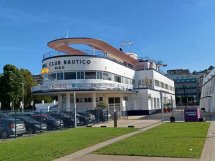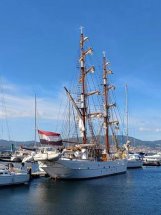Finisterre to Vigo

|
Finisterre to
Vigo Wednesday 28th
September N 42
15.0, W 008 46.0 We left you on
Friday 23rd at anchor in a bay sheltered from the predominantly northerly wind
in the Ria Finisterre, planning to sail to the Ria Arousa (or Arosa in some
sources). At the moment
it seems that the wind dies away to almost nothing at nights, which is great for
anchoring, is light north easterly in the mornings and becomes fresh north
westerly in the afternoons when the land heats up. On Saturday we
set off early for Arousa, bypassed the Ria de Muros on a whim and sailed 40
miles downwind until we turned up into the Ria and came onto the wind where we
had to shorten sail quite smartly.
This was the first time since we left Plymouth where we had to sail to
windward. For the non-sailors,
sailing downwind is blissful, the speed of the boat is subtracted from the wind
speed so the wind is always lighter than reality. When sailing towards the wind, the
boat speed is added to the wind speed so the difference between downwind and
upwind can be a real surprise.
In fact, sailing downwind can be a trap for the unwary and rather like
driving in the old days where you were advised to engage the same gear going
down hill as you would to go up the hill (showing our age here) a prudent sailor
should also reef (reduce sail) going downwind in fresh winds in case there is a
need to round up into the wind for any reason. The Ria Arousa
turned out be a much larger and windy expanse of water than we had envisaged but
we found a bay at Ribeira sheltered from the north and anchored overnight. Dinner on board that evening was tinned
tuna with potatoes fried in curry paste, and the remains of some carrots which
were spoiling. The following
morning, Sunday, we sailed another 8 miles or so upwind, tacking around rocks
and extensive shellfish farm enclosures that took up a lot of the space, to the
town of Pobra where we took a marina berth. Showers were appreciated followed by
bocodillos for lunch in the marina bar but all the shops were closed. However, a bit of local research by Phil
and Chris in the afternoon located an authentic, charming restaurant where we
enjoyed razor clams, baby squid and Manchego cheese with Serrano ham for
dinner. We shopped for
supplies on Monday morning and then set off south again in very light winds
toward the Ria de Vigo. By late morning the wind had piped up and we were inside
(east) of the Isla Ons, which is a National Park. You need to have permission to
navigate in the vicinity of the parks and then an extension to this to anchor.
We achieved most of this with an online application as we approached the island
and anchored for lunch. Continuing
south in the afternoon we approached the Ria de Vigo and the wind increased
necessitating a reef. Altering course, we put in another reef and sailed fast
into the Ria and anchored overnight in Cangas Bay, opposite Vigo. Phil cooked
mussels. On Tuesday
morning we moved into the marina Rodeiro at Cangas and took a ferry across the Ria which
happened to disembark opposite the Real Club Nautico Vigo so we had some lunch
there in a restaurant shaped like a large ship on the waterfront. We are beginning to appreciate the
Spanish tradition of serving a gratis tapas dish with
drinks. but,
occasionally, one of them (they say one in thirteen) turns out to be super hot
which amuses the other diners; it’s
a culinary version of Russian Roulette.
|





